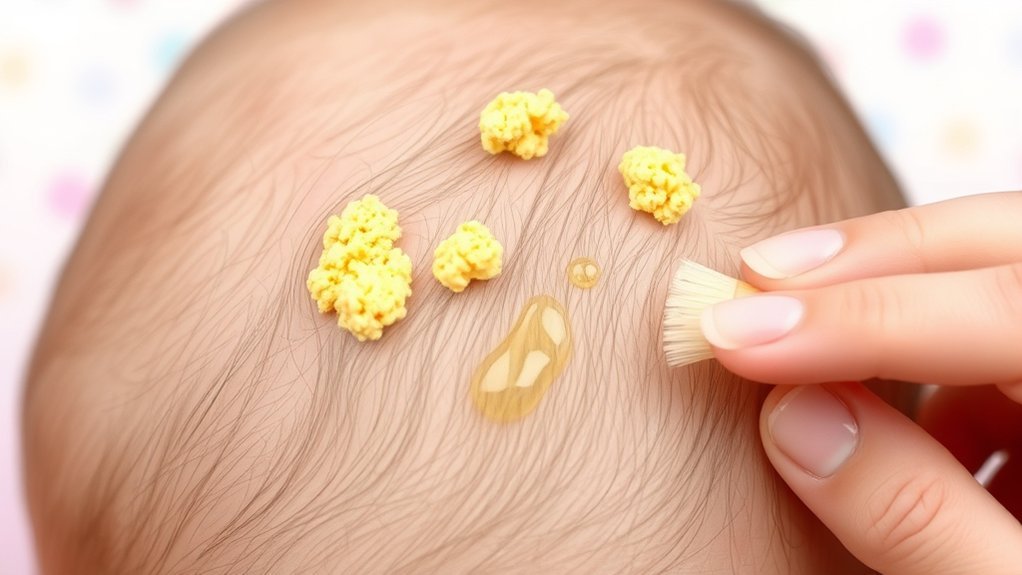If your infant has developed flaky, yellowish patches on their scalp, you might be observing cradle cap. This common condition can be concerning for many parents, but it’s typically harmless. Understanding the symptoms and signs is essential for effective management. By recognizing when it’s mild versus severe, you can better decide on the right care strategies. Let’s explore how to identify cradle cap and what steps you can take to guarantee your baby’s comfort.
Understanding Cradle Cap: What Is It?
Cradle cap, clinically known as seborrheic dermatitis, is a common skin condition that affects many infants. It typically appears as scaly patches on the scalp, which can be alarming for new parents. You might notice yellowish, greasy flakes that seem stuck to your baby’s head. While the exact cause isn’t fully understood, it’s believed to be related to excess oil production and yeast on the skin. Cradle cap isn’t contagious, nor is it a sign of poor hygiene, so there’s no need for concern. It usually resolves on its own over time. Understanding that this condition is common can help ease your worries as you navigate your baby’s early months. Knowing what cradle cap is can empower you to care for your little one effectively.
Common Symptoms of Cradle Cap
When you look at your baby’s scalp, you might notice some telltale signs of cradle cap. You’ll likely see flaky, yellowish, or greasy patches on the scalp. These patches can vary in size and may appear crusty or scaly. In some cases, the affected skin might become red or inflamed, but it’s important to remember that cradle cap is generally harmless. You may not notice any discomfort in your baby, as cradle cap usually doesn’t cause itching or pain. However, if you see excessive scaling or if the condition seems to worsen, it’s wise to consult your pediatrician. Being aware of these common symptoms can help you manage your baby’s cradle cap effectively and compassionately.
Identifying the Severity of Cradle Cap
How can you determine the severity of your baby’s cradle cap? Start by observing the extent and appearance of the flakes. Mild cases might show only a few patches, while severe cases can cover larger areas, leading to thick, crusty scales. Use the table below to identify the severity:
| Severity | Description |
|---|---|
| Mild | Few patches of dry, flaky skin |
| Moderate | Scaly areas that may cover the scalp |
| Severe | Thick, crusty scales; potential redness |
| Very Severe | Extensive scaling, inflammation, or sores |
Effective Home Care Strategies
To effectively manage cradle cap at home, it’s important to adopt a few simple strategies that can help soothe your baby’s scalp. Start by gently washing your baby’s hair with a mild baby shampoo several times a week to keep the scalp clean. After washing, use a soft brush or cloth to gently loosen and remove scales. You might also consider applying a small amount of mineral oil or baby oil to the affected areas to soften crusts before brushing. Be patient and consistent, as it can take some time for the condition to improve. Always keep an eye on your baby’s scalp, and if you notice any signs of redness or infection, it’s best to consult a healthcare professional.
When to Consult a Pediatrician
If you notice that your baby’s cradle cap isn’t improving with home care or seems to be getting worse, it’s important to seek advice from a pediatrician. Look for signs of infection, such as redness, swelling, or oozing from the affected area. If your baby experiences excessive itching or discomfort, consulting a pediatrician is essential. Additionally, if you see cradle cap persisting beyond a few months or if it spreads to other areas, professional guidance is necessary. Your pediatrician can recommend appropriate treatments, ensuring your baby’s skin health is prioritized. Remember, you’re not alone in this; seeking help is a proactive step towards your baby’s well-being. Trust your instincts, and don’t hesitate to reach out for support.
Frequently Asked Questions
Can Cradle Cap Affect Older Children or Adults?
Cradle cap typically affects infants, but it can persist into childhood or even adulthood. If you notice similar symptoms in older children or adults, it’s best to consult a healthcare professional for appropriate treatment.
Is Cradle Cap Contagious to Others?
No, cradle cap isn’t contagious. You won’t catch it from your child, nor will they spread it to others. It’s simply a common skin condition, often caused by oil production, not an infectious ailment.
What Causes Cradle Cap in Infants?
Cradle cap in infants is often caused by overactive sebaceous glands, hormonal changes, or an imbalance of skin bacteria. It’s not harmful, and with gentle care, it usually resolves on its own.
Are There Any Long-Term Effects of Cradle Cap?
While cradle cap’s usually harmless, you shouldn’t throw caution to the wind. In rare cases, it can lead to skin infections or permanent scalp issues if not treated properly. Keep monitoring your baby’s scalp health.
Can I Use Regular Shampoo on Cradle Cap?
You shouldn’t use regular shampoo on cradle cap, as it may irritate your baby’s sensitive skin. Instead, opt for a gentle baby shampoo or specific cradle cap treatments designed to soothe and cleanse effectively.
Conclusion
In conclusion, while cradle cap can be concerning, it’s usually harmless and often resolves on its own. You might worry that it’ll cause discomfort for your baby, but most infants don’t experience itching or pain. By practicing gentle care at home and monitoring the condition, you can help soothe your baby’s scalp. Remember, if you notice worsening symptoms, don’t hesitate to reach out to a pediatrician for guidance and reassurance. Your baby’s comfort is paramount.
